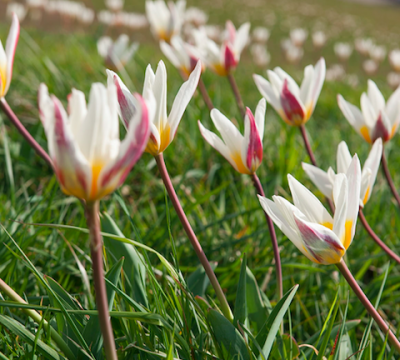birthe leemeijer
Birthe Leemeijer (Amsterdam, 1972) likes to fathom the essence of things, such as a journey, a polder, a forest or collecting. She begins by capturing unsightly, yet crucial signals of a particular place or situation, and subsequently questions them, thoroughly. This process gives rise to a tangible image, an object or a story. Watching, listening and letting things happen may be her most vital tools in arriving at a concept. Her work is often realised at a specifically suited location. The expectations, clichés and mechanisms that the environment evokes, are used as instruments to influence perception.
Birthe Leemeijer graduated from the Rietveld Academy and the Sandberg Institute in Amsterdam. In 1997 she won the Prix de Rome Basic Award for Art and Public Space.
Sheer wilderness
In spring, over ten thousand acres of meadow colour shades of pink, red, orange and yellow. The spectacle of the flowering tulips in the Bollenstreek draws hundreds of thousands of tourists annually, who view the ‘Tulipa’, as the monocot from the lily family is officially called, as a typically Dutch symbol. And yet, this symbol has an exotic ancestry. The flower originates from the far East, the mountains of Kazakhstan. But as a by-product of the conquests of Turkish sultan Süleyman I, the tulip made its way to Turkey in the sixteenth century, then to Antwerp, eventually arriving in The Netherlands.
The early flowering tulip has, through the centuries, been the subject of elaborate scientific research in flower breeding. She was cultured, cross bred, diseases were eliminated: all so that the flower might be large and full, her stem so strong that it could contend with the harshest of Dutch southwesterly winds, and her colours could expel Dutch sobriety. From the loveliest of whites to near black purple, from hazy pink to practically obscene wildly flamed contraptions: tulips appeared in all shapes and sizes, all tastes and vases. They evolved from status symbol and object of investment in the sixteenth century to the multi-buy supersavers they are today: in the high season, you can buy ten bunches for a tenner at the market.
Birthe Leemeijer (1972) discerningly demonstrates the substantial difference between the tulip we know today, and the original tulip, wildly tillering in Kazakhstan. Her project, The Boundless Gardens, which began in 2013 in Diepenheim, travelled from Utrecht to Delft and is now continued in and around the Noletloodsen in Schiedam, focuses on the wild tulip. Leemeijer allows five species to shine in delicate grace, for wild tulips are much finer and more fragile than cultured bulbs. Where in The Boundless Gardens in Diepenheim, the tulips — seventy thousand in total — stood idyllically amongst the green fields, meadows and woodland; here in Schiedam the flowers are forced to fight the industrial and sometimes heavily polluted landscape.
In November 2015, with the help of roughly one hundred volunteers and a group of school children, and spanning nine planting sessions, Leemeijer buried ten thousand tulip bulbs across the outskirts of the industrial area. In some parts, the ground was literally rubbish.
The project The Boundless Gardens doesn’t just change the outskirts of the city into a wealth of flowers; it also turns the attention to social issues, such as that of environmental pollution and a sense of community. Volunteers of all social classes and a variety of backgrounds joined forces — initially with occasional scepticism. ‘My dog will dig those bulbs up in no time.’
In April and May of this year, we shall see how many of the bulbs come up. Whether the fields surrounding the grey warehouses, the lawns in the Plantage, the edges of earth along the Nieuwe Haven have changed into an undulating palette of colour tufts. Additionally, inside the Noletloodsen, Leemeijer projects around ten thousand slides, legacy of Wim Lemmers. Lemmers is the leading ‘tulip tracker’ of our time. For twenty years, the bulb expert scoured near impassable areas of primal nature, where the flower originates from and where the bulb blossoms under often even more difficult circumstances than in Schiedam. Lemmers’ travels took him to Kazakhstan, Uzbekistan, Turkmenistan and Iran. During one of these trips, he discovered a yet unknown tulip species, which received his name: the Tulipa lemmersii.
The tens of thousands of slides Lemmers took along the way, were digitalised by Leemeijer. Thus Lemmers’ knowledge is preserved for future generations and spread amongst a wider public than tulip experts alone. Even non-experts of tulips will now see the beauty of the recordings, the breathtaking mountainous landscapes Lemmers trekked through, the delicacy with which a tiny flower blossoms between the rocks and how moving it can be that a man would travel so many thousands of miles, to capture just that image.


